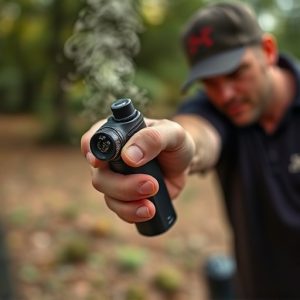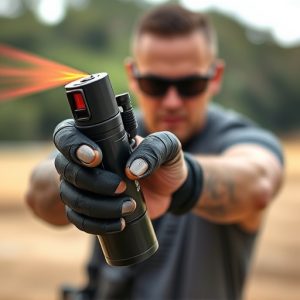Crowd Control Pepper Spray: Techniques, Safety, Law & Ethics
Crowd Control Pepper Spray Techniques utilize capsaicin, the heat compound in chili peppers, as a no…….
Crowd Control Pepper Spray Techniques utilize capsaicin, the heat compound in chili peppers, as a non-lethal tool for managing large gatherings and potential civil disturbances. When inhaled or absorbed, capsaicin binds to nerve receptors, causing temporary discomfort and disrupting coordination. Modern pepper spray devices employ specialized nozzles and smart sensors to maximize coverage while minimizing impact on bystanders. Proper training is crucial for law enforcement to balance effectiveness with safety, adhering to legal guidelines regarding duration, concentration, and targeted application. Despite debates about its ethical implications, crowd control pepper spray remains a preferred choice for maintaining public order in challenging situations.
“Uncovering the power of science in crowd control, this article explores Capsaicin-based inflammatory crowd control sprays as a unique non-lethal solution. We delve into the active ingredient’s properties and its mechanism of action, understanding how it disrupts normal bodily functions to achieve temporary incapacitation.
From deployment techniques to safety measures and legal considerations, we provide an all-encompassing guide on Crowd Control Pepper Spray Techniques, offering insights for informed decision-making in various sectors.”
- Understanding Capsaicin: The Active Ingredient
- How Crowd Control Pepper Spray Works
- Different Techniques for Effective Deployment
- Safety Considerations and Training
- Legal and Ethical Implications of Using Pepper Spray
Understanding Capsaicin: The Active Ingredient
Capsaicin, the active ingredient in pepper spray, is a natural compound derived from chili peppers. It’s what gives these spices their heat and pungent flavor. In crowd control scenarios, capsaicin isn’t just about delivering a burning sensation; it triggers a complex physiological response in the human body. When inhaled or absorbed through mucous membranes, capsaicin binds to specific receptors in the nervous system, leading to temporary but intense discomfort, tearing, coughing, and difficulty breathing. This reaction is crucial in crowd control techniques as it disrupts the coordination and mobility of individuals, enabling easier control and dispersal.
The effectiveness of capsaicin-based crowd control spray lies in its non-lethal nature and rapid onset. It’s a game-changer in law enforcement and security protocols, offering a safe alternative to traditional crowd control methods. Unlike other pepper sprays, capsaicin is less likely to cause long-term damage or leave individuals completely incapacitated, making it a preferred choice for managing large gatherings and potential civil disturbances.
How Crowd Control Pepper Spray Works
Crowd control pepper spray, a potent tool in law enforcement and security protocols, harnesses the power of capsaicin to disrupt and manage large gatherings. This chemical compound, commonly found in chili peppers, is responsible for the burning sensation associated with spicy foods. When deployed as a spray, it quickly irritates the eyes, nose, and respiratory system, leading to temporary yet significant disorientation and discomfort among those affected.
The effectiveness of crowd control pepper spray lies in its ability to impair visual clarity and breathing capabilities. The spray forms a dense cloud that reduces visibility, making it challenging for individuals within the affected area to navigate or coordinate their actions. This impairment disrupts potential violent encounters and provides critical time for law enforcement to gain control and de-escalate situations. Moreover, the non-lethal nature of the spray ensures minimal physical harm while still enabling authorities to maintain order efficiently.
Different Techniques for Effective Deployment
In the realm of crowd control, various techniques have been developed to deploy capsaicin-based inflammatory sprays effectively. One primary method involves the use of specialized nozzles and fogging systems that distribute the spray as a fine mist, ensuring maximum coverage while minimizing direct impact on bystanders. This technique is particularly useful in open spaces like stadiums or public squares, where quick dispersal and control are essential.
Additionally, advanced crowd control pepper spray devices incorporate smart sensors and GPS tracking for precise deployment. These tools allow law enforcement to target specific areas, preventing indiscriminate use and reducing the risk of accidental exposure. In terms of Crowd Control Pepper Spray Techniques, these innovative solutions offer a balance between effectiveness and safety, making them valuable assets in managing large gatherings and maintaining public order.
Safety Considerations and Training
When employing a capsaicin-based inflammatory crowd control spray, safety considerations are paramount. This powerful tool is designed to disrupt and disperse crowds, but its use requires careful training and adherence to best practices. Law enforcement agencies and security personnel must be adequately trained in the correct application techniques to ensure both effectiveness and minimal harm to bystanders or individuals with medical conditions.
Training should cover the identification of appropriate scenarios for pepper spray deployment, proper handling of the equipment, and understanding the effects of capsaicin on different populations. It is crucial to familiarize yourself with local regulations and guidelines governing the use of crowd control measures, including the specific types of pepper spray permitted and the circumstances under which their use is authorized. Regular refresher courses can help maintain proficiency in these critical crowd control pepper spray techniques.
Legal and Ethical Implications of Using Pepper Spray
The use of crowd control pepper spray, derived from capsaicin, has sparked debates regarding its legal and ethical dimensions. While it is an effective technique for managing large gatherings and potential violence, it raises concerns about public safety and individual rights. In many jurisdictions, law enforcement agencies are permitted to employ crowd control pepper spray as a non-lethal force measure under specific circumstances. However, the ethical implications arise when considering its impact on bystanders, individuals with respiratory conditions, and those who may not be actively engaging in violent behavior but are caught in the crossfire.
Crowd control pepper spray techniques must balance public order maintenance with proportionality and respect for human rights. The legal framework surrounding its use often includes guidelines on duration, concentration, and targeted application to minimize harm. As technology advances, developing safer alternatives or refining existing formulations could address ethical concerns, ensuring that crowd control measures are both effective and humane.
Capsaicin-based crowd control spray represents a potent tool for law enforcement, offering rapid and effective inflammatory responses. By understanding its active ingredient, mechanisms of action, and employing optimal deployment techniques, professionals can harness its power responsibly while prioritizing safety and ethical considerations. Legal frameworks and ongoing discussions further underscore the need for rigorous training and informed use of these innovative Crowd Control Pepper Spray Techniques in modern security protocols.


